PROCIDA
A maritime history, of oars and sails, of anglers and courageous captains:
Copyright video, pics and tests © 2020
This is the story of Procida, quiet and tiny (3,7 square kilometres), immersed in the Tyrrhenian Sea as the pearl of a wild oyster, so charming that it solicits medieval fantasies, poems and visions of narrators sent to routes of far paradises.
Nowadays, the summer sailors arrive, and it is fundamental place for artists, a wonderful set for cinema. And if the stars of the silver screen feed the myths of the present, they recall a path already drawn in literature masterpieces, from Virgil to Horace, from Juvenal to Boccaccio, until “Graziella”, Alphonse de Lamartine’s novel, a French diplomatic stationed in Naples, who drowned off the island during a fishing trip.
The young coral worker, daughter of a fisherman, fell in love with Lamartine, who described her with these words: “Her eyes, large and oval in form, were of that undecided colour between deep black and the blue of the sea… a celestial colour which the eyes of the Asiatic and Italian women borrow from the brilliant light of their fiery days and from the serene blue of their heaven, their sea and their nights.”

Procida is the smallest of the Neapolitan islands. Its special charm may be the result of the unusual combination of its proud maritime heritage and strong rural identity. The name comes from Prochyta, which means “abundant”. It is lifted from the waters and inserted in the volcanic context of the Phlegraean area. We can identify seven craters around the island’s coastline, characterised by cliffs and beaches inside coves and bays. Archaeological finds discovered on the neighbouring islet of Vivara show that Procida was inhabited by Mycenaeans from the 17th and 16th centuries BC: when it became an important crossroad for the manufacture and trade of metals. The most recent past recalls the story of the feudal lord Giovanni da Procida, famous for having organised the Sicilian Vespers.
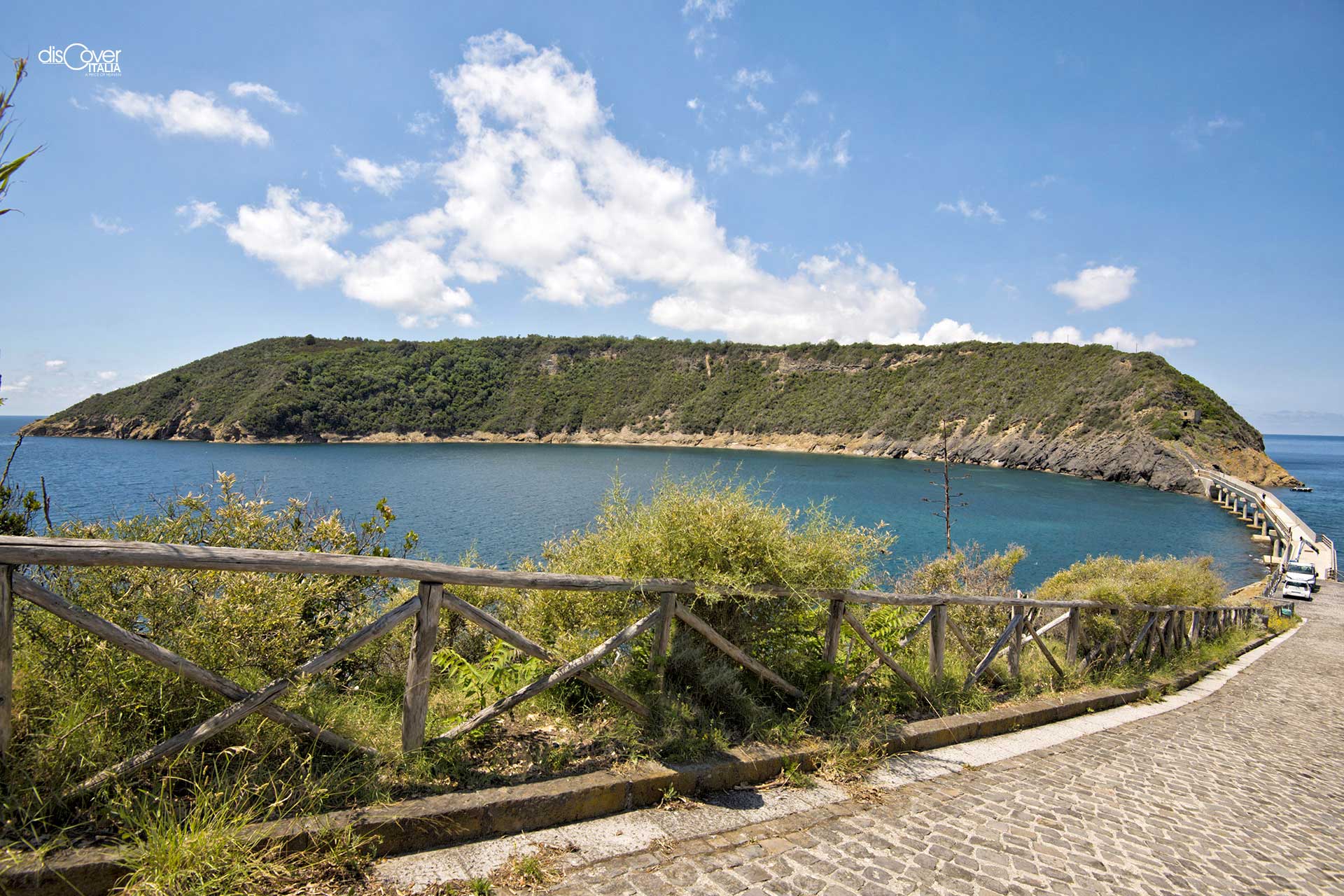
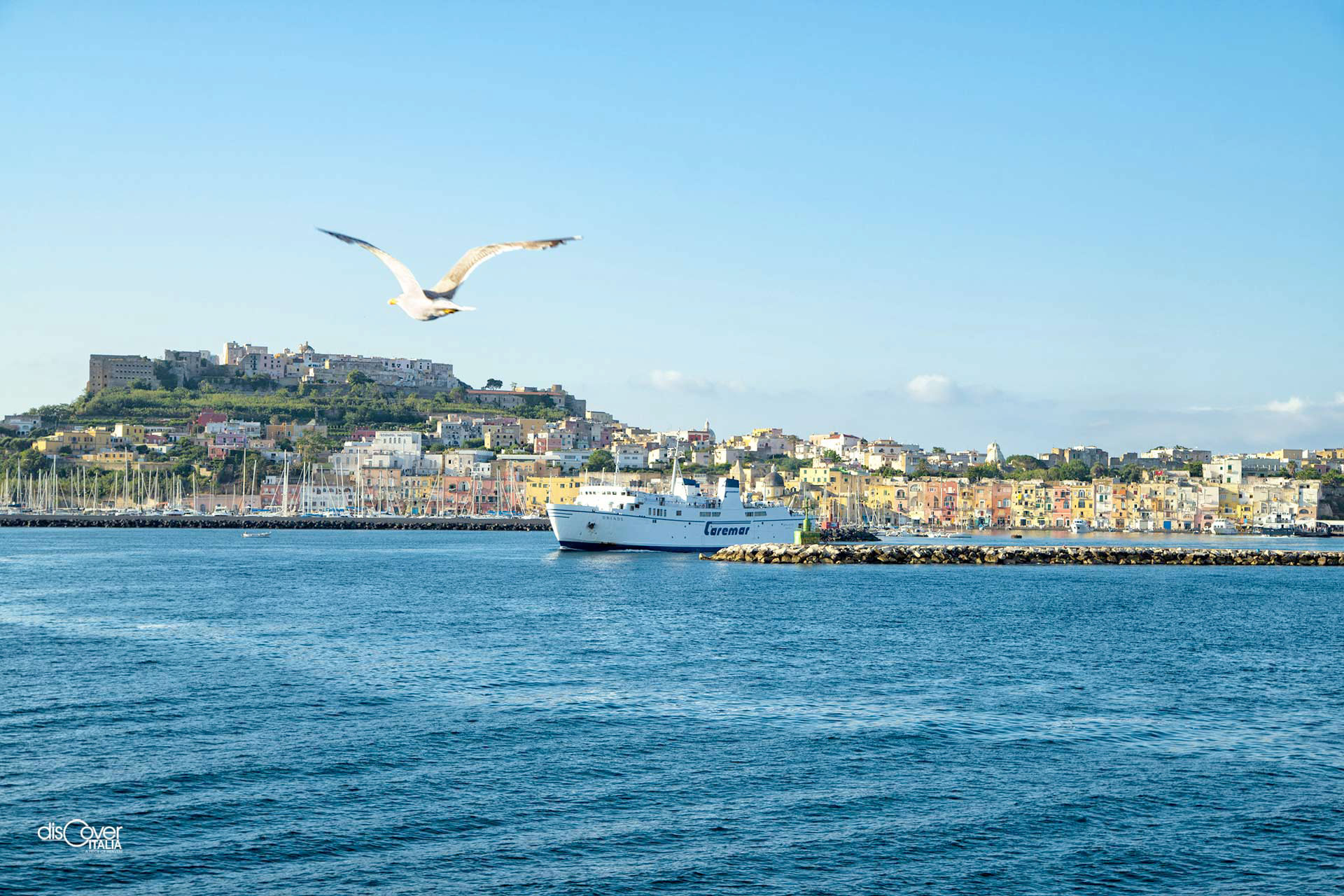 The most attractive aspect of the island is the architecture of the houses, which forms the heart of its old hamlets. The houses are colourful so that they could be recognised from far away by sailors out at sea; they are original, almost set together like the pieces of a puzzle: travellers are impressed as soon as they land at Marina Grande, the commercial port is next to a small harbour for fishing-boats and a tourist marine. The visual impact is captivating immediately. Not surprisingly, Cesare Brandi, founder of the Institution for Restauration in Rome, enhanced these breath-taking views, highlighting the “row of tall multi-colored houses tightly set like a barricade, with several arches half closed as if they were winking.” They are the symbol an architecture which “is Mediterranean and represents the living vestiges of the late Roman and Byzantine architecture. Nothing but arches and vaults, with some external staircases as pleasing as a compliment”. Emblematic expressions are leading along the paths and Procida itineraries.
The most attractive aspect of the island is the architecture of the houses, which forms the heart of its old hamlets. The houses are colourful so that they could be recognised from far away by sailors out at sea; they are original, almost set together like the pieces of a puzzle: travellers are impressed as soon as they land at Marina Grande, the commercial port is next to a small harbour for fishing-boats and a tourist marine. The visual impact is captivating immediately. Not surprisingly, Cesare Brandi, founder of the Institution for Restauration in Rome, enhanced these breath-taking views, highlighting the “row of tall multi-colored houses tightly set like a barricade, with several arches half closed as if they were winking.” They are the symbol an architecture which “is Mediterranean and represents the living vestiges of the late Roman and Byzantine architecture. Nothing but arches and vaults, with some external staircases as pleasing as a compliment”. Emblematic expressions are leading along the paths and Procida itineraries.
 Palazzo Montefusco, known as Palazzo della Catena (set as a mobile barrier at the entrance so that it could not allow people to enter). It was already a summer retreat for the royal family. In this area, characterised in the past by recoveries excavated in the tuff in order to keep the boats out of the water, there are shipyards, evident signs of the historic activities and vocations of inhabitants. On the right, westward, there is a beach called Spiaggia delle Grotte, also known as Spiaggia della Silurenza. To the left of the dock, there is the lido della Lingua, usually invaded by people arriving from Pozzuoli and Naples by ferry. From Via Roma, between restaurants, shops and bars, you enter in the heart of Procida’s main drag. There, you can see another symbol of its identity: a wooden crucifix, which, since 1845, has been the testimony of the sailors devotion, near Sent’ Co’ square (dialect word meaning Sancio Cattolico), which is the main attraction for the most important folklore and public events, with the church of Santa Maria della Pietà, whose chapel (the first nucleus) is from 1616. Walking along the new port, you can notice a distant suggestion, among the places where Alphonse de Lamartine, the author of Graziella, has stayed and which has transformed into a global myth the virtues of Procida’s women. The novel has been written in 1852, apparently after he drowned during a storm off the island. The writer fell in love with a young lady from Procida who died of love after Lamartine had left Paris. But the story highlights his love for the island. A building from 1786, with a high doorway, is the headquarter of the Nautical Institute Francesco Caracciolo, the oldest in Europe.
Palazzo Montefusco, known as Palazzo della Catena (set as a mobile barrier at the entrance so that it could not allow people to enter). It was already a summer retreat for the royal family. In this area, characterised in the past by recoveries excavated in the tuff in order to keep the boats out of the water, there are shipyards, evident signs of the historic activities and vocations of inhabitants. On the right, westward, there is a beach called Spiaggia delle Grotte, also known as Spiaggia della Silurenza. To the left of the dock, there is the lido della Lingua, usually invaded by people arriving from Pozzuoli and Naples by ferry. From Via Roma, between restaurants, shops and bars, you enter in the heart of Procida’s main drag. There, you can see another symbol of its identity: a wooden crucifix, which, since 1845, has been the testimony of the sailors devotion, near Sent’ Co’ square (dialect word meaning Sancio Cattolico), which is the main attraction for the most important folklore and public events, with the church of Santa Maria della Pietà, whose chapel (the first nucleus) is from 1616. Walking along the new port, you can notice a distant suggestion, among the places where Alphonse de Lamartine, the author of Graziella, has stayed and which has transformed into a global myth the virtues of Procida’s women. The novel has been written in 1852, apparently after he drowned during a storm off the island. The writer fell in love with a young lady from Procida who died of love after Lamartine had left Paris. But the story highlights his love for the island. A building from 1786, with a high doorway, is the headquarter of the Nautical Institute Francesco Caracciolo, the oldest in Europe.
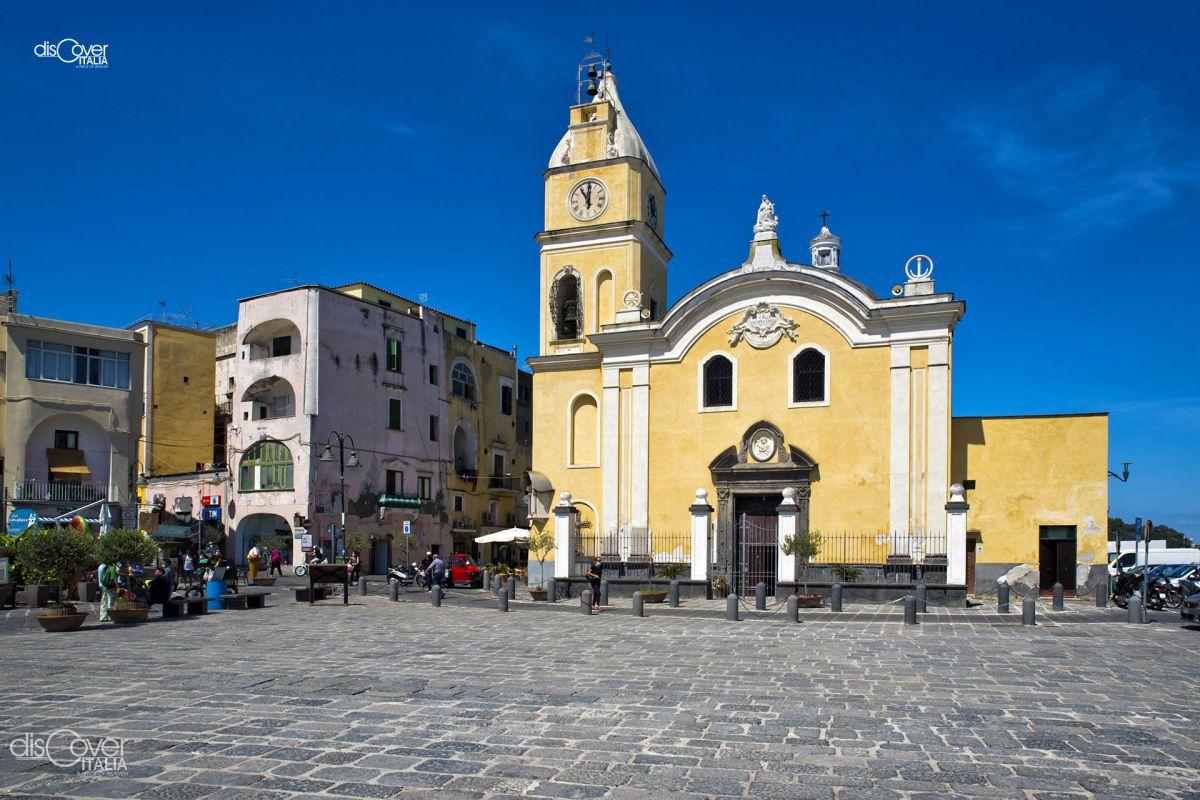
From Via Vittoria Emanuele II, you will be in the old centre of Procida passing through the church dedicated to San Leonardo (end of 16th century), who was the patron saint of the slaves, of the island inhabitants captured during the Barbaric invasions.
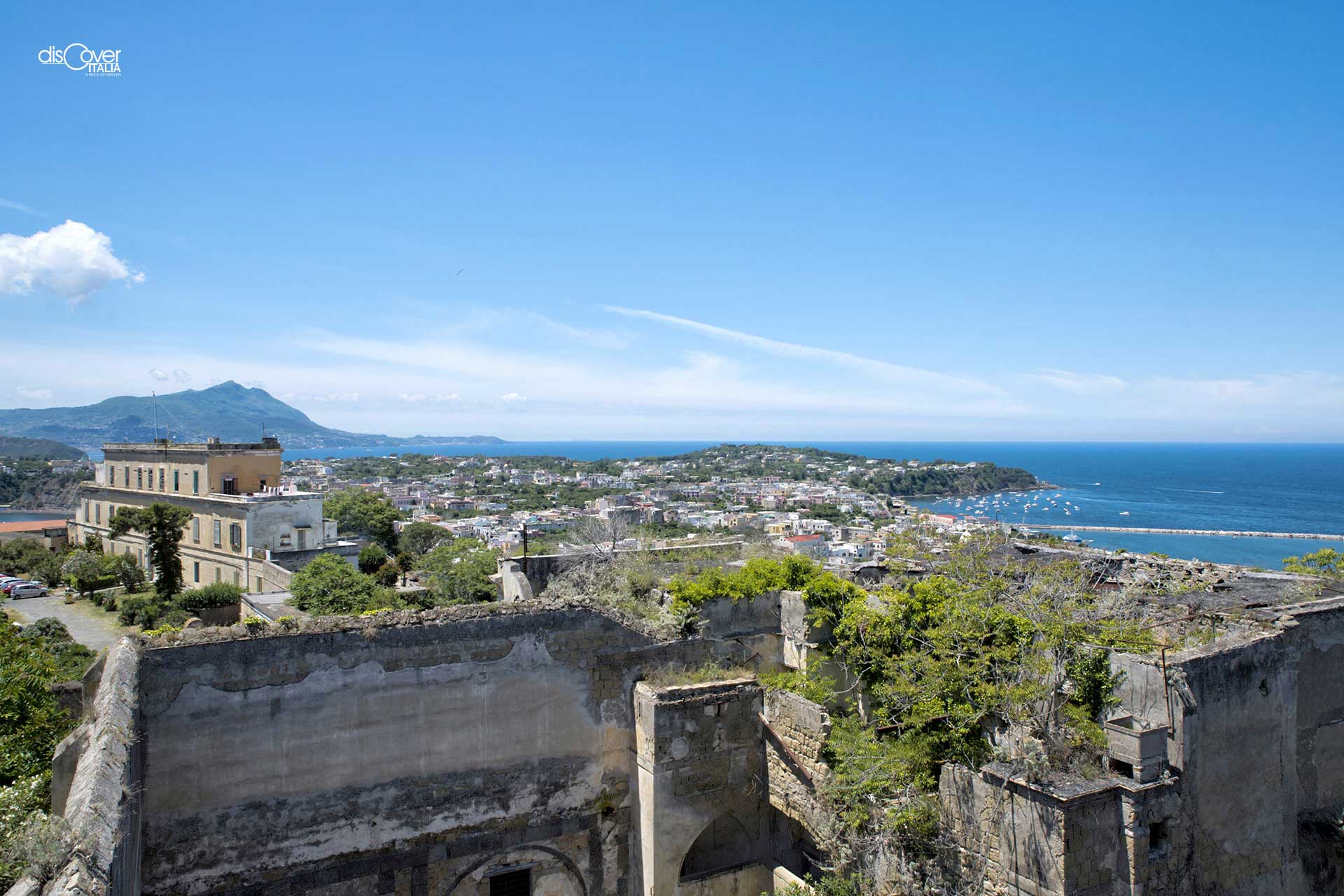 The architecture of Terra Murata, Marina Corricella and Casale Vascello are a succession of enchanting views. Terra Murata is, in fact, the fortress of Procida, and it is the wonderful synthesis of the most captivating emotions, transformed in unforgettable pages of literature by Elsa Morante, author of Arturo’s Island. In Terra Murata, there is the Abbey of San Michael, the patron saint of the island. It was a shelter when the island was attacked by pirates.
The architecture of Terra Murata, Marina Corricella and Casale Vascello are a succession of enchanting views. Terra Murata is, in fact, the fortress of Procida, and it is the wonderful synthesis of the most captivating emotions, transformed in unforgettable pages of literature by Elsa Morante, author of Arturo’s Island. In Terra Murata, there is the Abbey of San Michael, the patron saint of the island. It was a shelter when the island was attacked by pirates.
The abbey is the emblem of the history and it is an art gallery full of books and extraordinary testimonies of the past. It dates from the year 1000, when it hosted a Benedictine community, and was then secularised in the 15th century: It has suffered devastations, fires and raids during the invasions. In the apse, there is an art gallery with a painting of Nicola Russo from 1690 representing the sinking of the Barbarians fleet thanks to the miraculous intervention of the protector Archangel, but the whole context of the underlying spaces, with the orators belonging to different congregations, is full of charm. Next to it, there is the Castle of Avalos, an imposing building of the 16th century, also known as the Royal Palace: during the Bourbon reign, it was used as the residence of the sovereign. The king stopped in Procida, which was one of the many royal hunting sites, to catch pheasants.
In 1800, the Castle was modified and used as a Casa Penale (a prison) and was closed in 1986. After a partial restoration, for few years it is possible to visit it.
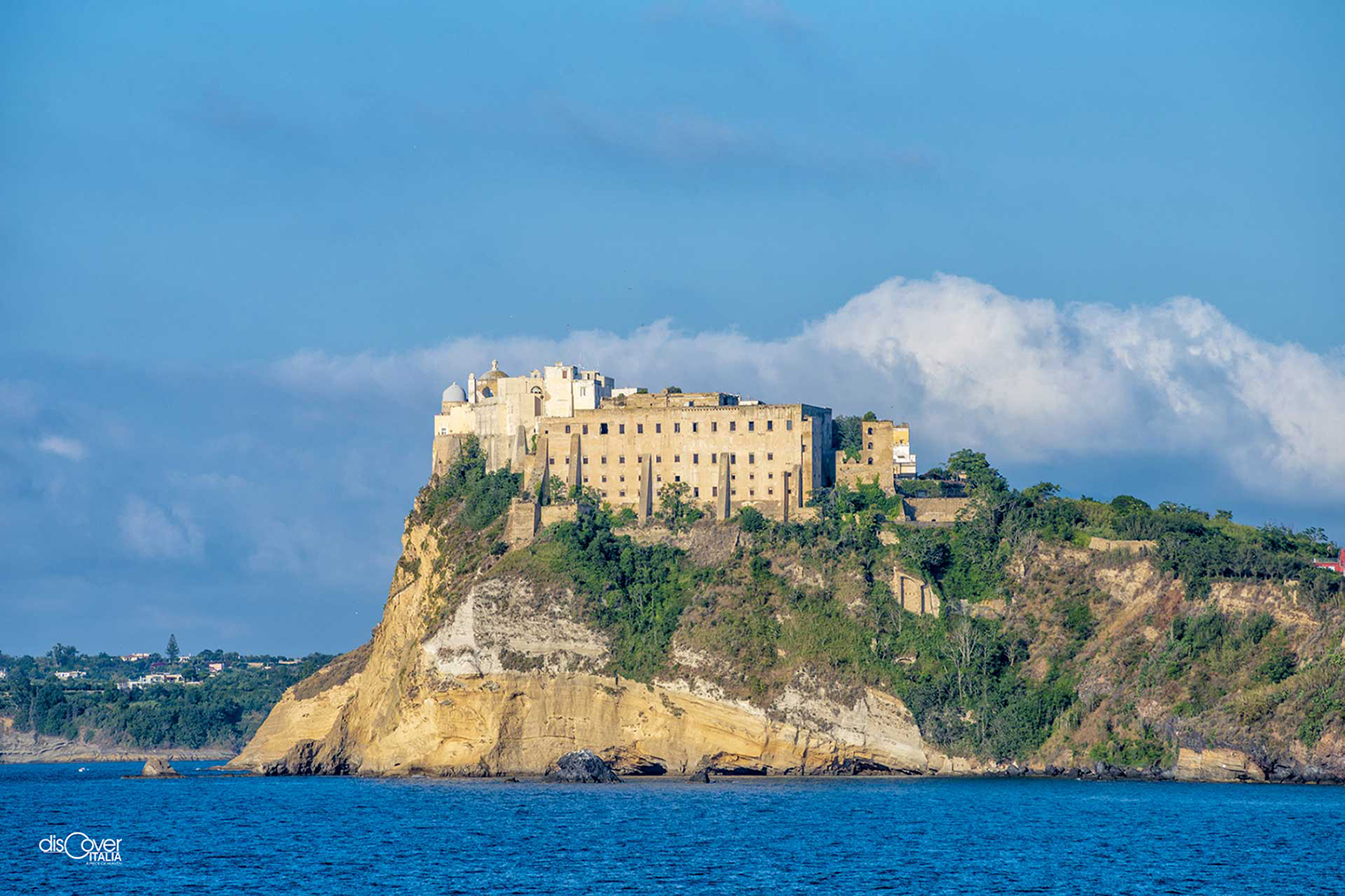
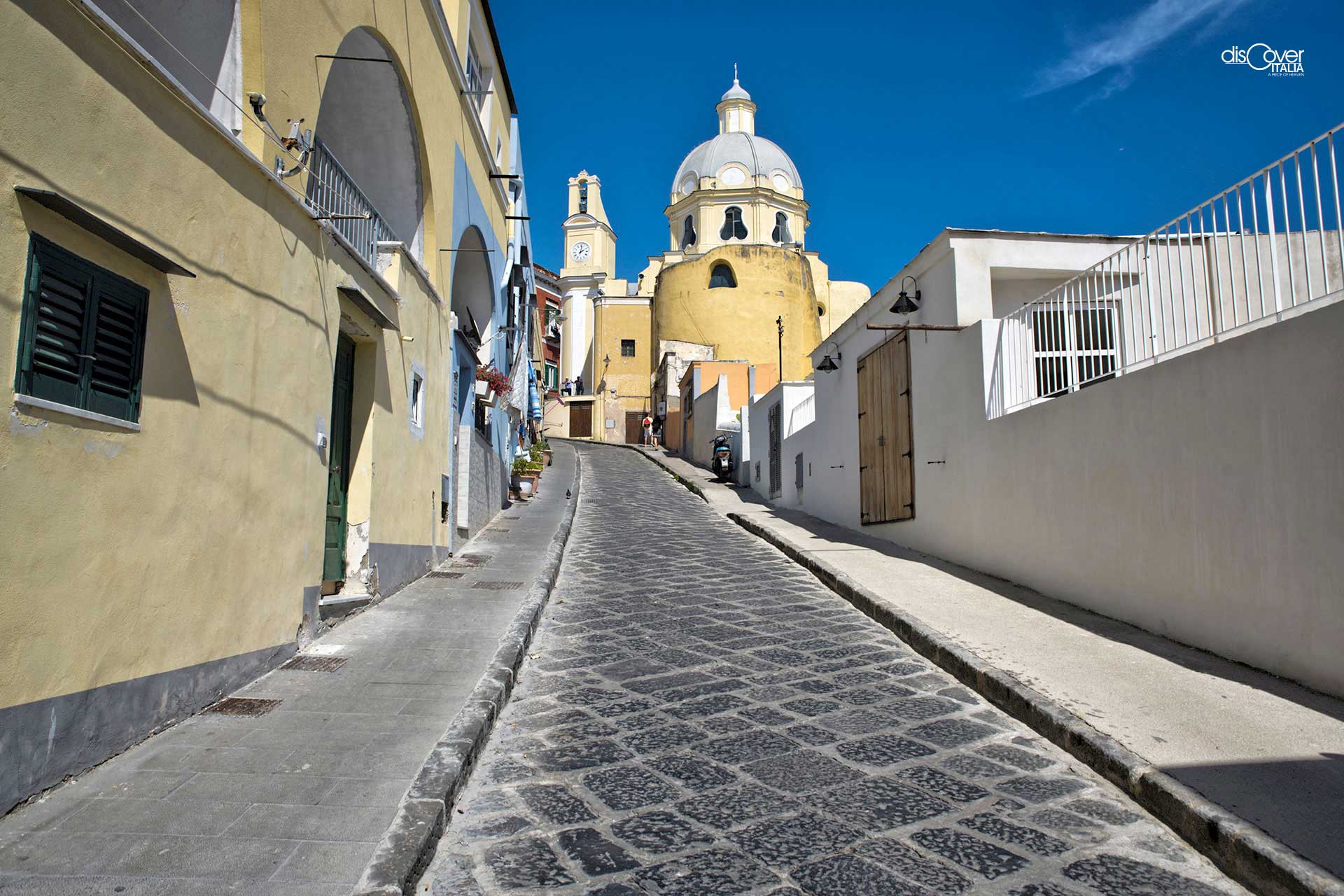 You can reach Casale Vascello from Piazza dei Martiri, where patriots who had adhered to the Neapolitan Republic of 1799 were hanged. It is a large courtyard partly encircled by the row oh houses with three levels and dominated by the characteristic church of Santa Maria delle Grazie, overlooking the beautiful panorama of Corricella. It was the first building core built outside the Medieval hamlet of Terra Murata, and datable around the end of the 16th century.
You can reach Casale Vascello from Piazza dei Martiri, where patriots who had adhered to the Neapolitan Republic of 1799 were hanged. It is a large courtyard partly encircled by the row oh houses with three levels and dominated by the characteristic church of Santa Maria delle Grazie, overlooking the beautiful panorama of Corricella. It was the first building core built outside the Medieval hamlet of Terra Murata, and datable around the end of the 16th century.
The Corricella (from the Greek: kora kalè, «beautiful place”) is one of the favourite locations for filmmakers who choose Procida for the scenes of their film: it is a village of fishermen, but also a landing place for boating, and, especially, a perfect location for hospitality, with its restaurants and small shops. The houses, all clustered together, remember the nativity dimension, with terraces, stairways and shared balconies. You can get here through wide steps or narrow staircases like the characteristic Gradinata Scura, located in Callìa (another name of Greek origin referring to beauty ); then, the Gradinata Larga and the Gradinata del Pennino, the most frequented, in front of the small church of San Rocco (15th century). In a maze of narrow passages, they are road ways representing one of the aspects of the island mobility: from the centres, there are paths and stairs leading to coastal strip. At the Corricella, which is a pedestrian area, between sailors slow paces and monumental and panoramic visions, with the eco of the fishermen mending the nets, you are dazzled by a natural light, unique and special.
From Via San Rocco, through Callìa, you can reach Via Marcello Scotti, a scholar and a priest who was victim of the Bourbon reaction in 1799. The area, from Via Vittorio Emanuele to Piazza Olmo, is formed on the left by houses with beautiful internal courtyards and gardens, settlements of notables of the eighteenth and the beginning of the nineteenth century, such as Minichini, Romeo, Miramare or Scotto di Pagliara, and others dominating the sea and the Chiaia beach, towards which - from a panoramic viewpoint - the hills are surrounded by wonderful lemon groves. On the right, although lacking in direct walkways on the bay of Chiaia, there are the Palazzo Scotti also known as Mamozio (as the ornamental gargoyle of the gate is popularly called); Parascandola, Esposito, Figoli, and others. After the small church of San Vincenzo (1571), there is Via di Bagni, another small path leading to the lido. Between residential habitations and other houses (the Manzo is from 1865), you reach the church of Sant’Antonio Abate (17th century), at the beginning of Via Cavour. From there, you can either go to the De Jorio tower or to the fields and vineyards, in Starza, until walking the paths leading to Punta Pioppeto with its lighthouse, shone since 1849. Going backwards, you can discover other views of the countryside, until Punt Cottimo, to arrive at the Aragonese Defence Tower, one of the three towers built in 16th century by Don Pedro de Toledo, the viceroy of Naples.
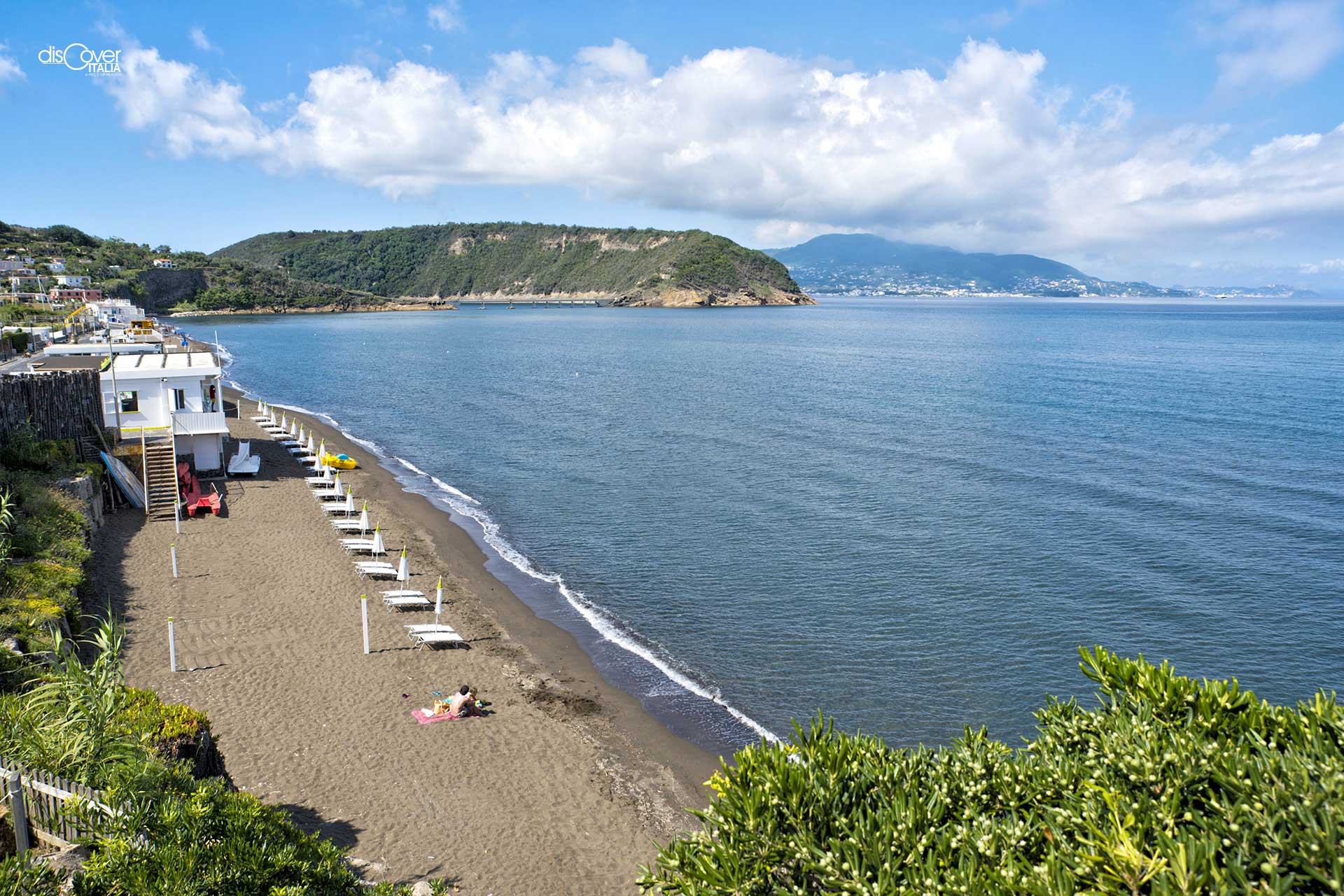
Passing again through vineyards and orchards, you reach to the top of the hill where there is a view of the cove of Pozzo Vecchio (one of the ancient craters), with the small beach today called “Spiaggia del Postino” (Postman’s Beach), after the scenes of Massimo Troisi’s film, dominated by the small cemetery and closed in the south by Punta Serra, beyond which the beach of Ciraccio extends. It ends with a strip of land joining the island to the promontory of Santa Margherita, forming a backdrop to the hamlet of Chaiolella. And from here, you can “jump” to the tiny island of Vivara (or Vivaro), an environmental, cultural and touristic resource of international value which, from 1956, is connected to Procida thanks to a small bridge built by the Cassa del Mezzogiorno (Fund for the South) in order to support the pipes of the aqueduct distributing drinkable water to the island of Ischia, coming from Serino continental source. To worthily welcome Princess Maria José, King Umberto di Savoia’s wife, access stairs were created, which were originally a gully. With its 34 hectares and three kilometers of coastal development, Vivara, with its thick scrub of flora and protected fauna, has been declared a National Nature Reserve, and it is a real nature’s laboratory. 800 floristic biotypes have been recorded, while there are few hundred of migratory and resident birds species, in an important archaeological context, since there are Mycenaean finds discovered in the area of Punta D’Alaca and in the waters of the Gulf of Naples .
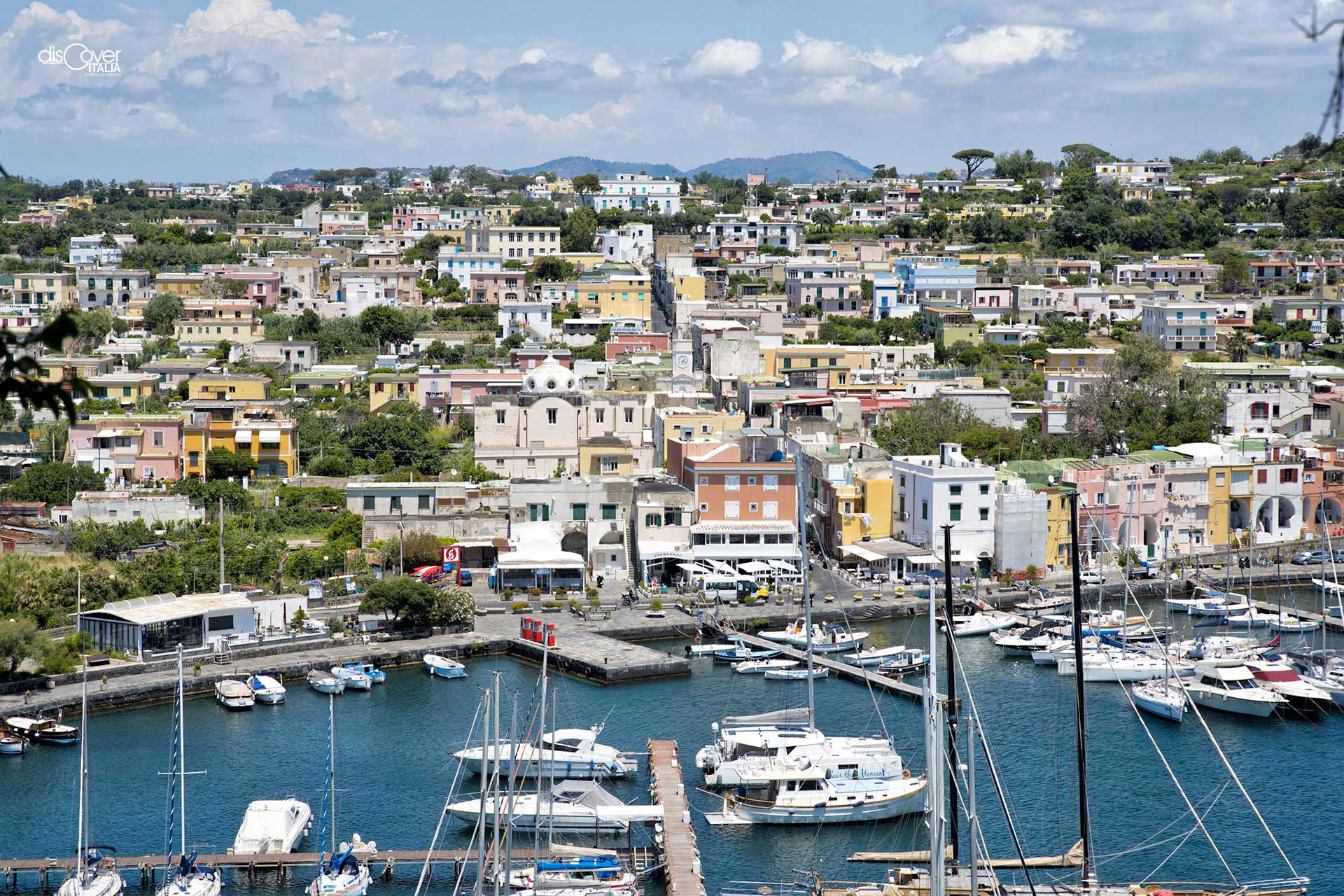



Comments powered by CComment